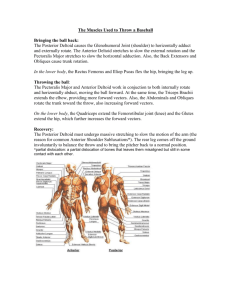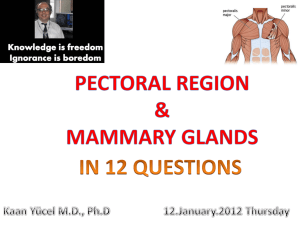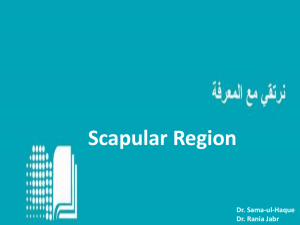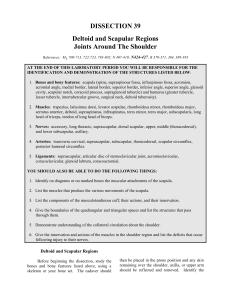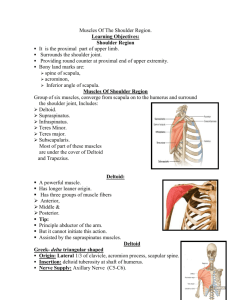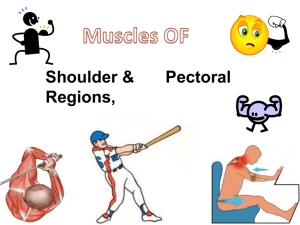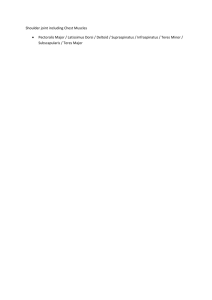Applied Anatomy and Physiology
advertisement
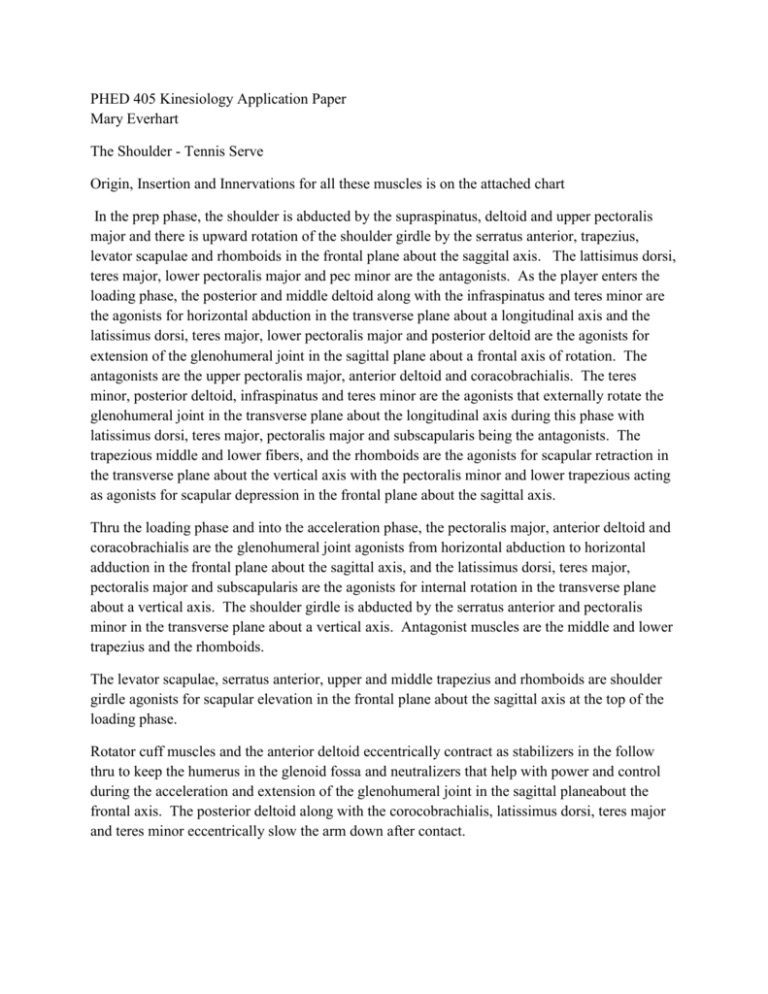
PHED 405 Kinesiology Application Paper Mary Everhart The Shoulder - Tennis Serve Origin, Insertion and Innervations for all these muscles is on the attached chart In the prep phase, the shoulder is abducted by the supraspinatus, deltoid and upper pectoralis major and there is upward rotation of the shoulder girdle by the serratus anterior, trapezius, levator scapulae and rhomboids in the frontal plane about the saggital axis. The lattisimus dorsi, teres major, lower pectoralis major and pec minor are the antagonists. As the player enters the loading phase, the posterior and middle deltoid along with the infraspinatus and teres minor are the agonists for horizontal abduction in the transverse plane about a longitudinal axis and the latissimus dorsi, teres major, lower pectoralis major and posterior deltoid are the agonists for extension of the glenohumeral joint in the sagittal plane about a frontal axis of rotation. The antagonists are the upper pectoralis major, anterior deltoid and coracobrachialis. The teres minor, posterior deltoid, infraspinatus and teres minor are the agonists that externally rotate the glenohumeral joint in the transverse plane about the longitudinal axis during this phase with latissimus dorsi, teres major, pectoralis major and subscapularis being the antagonists. The trapezious middle and lower fibers, and the rhomboids are the agonists for scapular retraction in the transverse plane about the vertical axis with the pectoralis minor and lower trapezious acting as agonists for scapular depression in the frontal plane about the sagittal axis. Thru the loading phase and into the acceleration phase, the pectoralis major, anterior deltoid and coracobrachialis are the glenohumeral joint agonists from horizontal abduction to horizontal adduction in the frontal plane about the sagittal axis, and the latissimus dorsi, teres major, pectoralis major and subscapularis are the agonists for internal rotation in the transverse plane about a vertical axis. The shoulder girdle is abducted by the serratus anterior and pectoralis minor in the transverse plane about a vertical axis. Antagonist muscles are the middle and lower trapezius and the rhomboids. The levator scapulae, serratus anterior, upper and middle trapezius and rhomboids are shoulder girdle agonists for scapular elevation in the frontal plane about the sagittal axis at the top of the loading phase. Rotator cuff muscles and the anterior deltoid eccentrically contract as stabilizers in the follow thru to keep the humerus in the glenoid fossa and neutralizers that help with power and control during the acceleration and extension of the glenohumeral joint in the sagittal planeabout the frontal axis. The posterior deltoid along with the corocobrachialis, latissimus dorsi, teres major and teres minor eccentrically slow the arm down after contact. Muscle Pectoralis Minor Serratus anterior Origin Anterior surfaces of the 3rd to 5th ribs Surface of the upper 9 ribs at the side of the chest Insertion Coracoid process of the scapula Anterior aspect of the whole length of the medial border of the scapula Posterior aspect of the lateral 3rd of the clavicle Trapezius upper fibers Base of skull, occipital protuberance and posterior ligaments of the neck Trapezius middle Spinous process of the Medial border of the fibers 7th cervical and upper acromion process and 3 thoracic vertebrae superior border of the scapular spine Trapezius lower fibers Spinous process of Triangular space the 4th to 12th thoracic the base of the vertebrae scapular spine Rhomboids Spinous process of Medial boarder of the the 7th cervical and scapula, inerior to the first 5 thoracic scapular spine vertebrae Levator Scapulae Transverse processes Medical boarder of of the upper 4 cervical the scapula from the vertebrae superior angle to the scapular spine Pectoralis Major Medial half of the Flat tendon 2 or 3 Upper fibers anterior surface of the inches wide to later clavicle lip of the intertubercular groove of the humerus Pectoralis Major Anterior surface of Flat tendon 2 or 3 Lower fibers costal cartilages of inches wide to later first six ribs, and lip of the adjoining portion of intertubercular groove sternum of the humerus Subscapularis Anterior surface of Lesser tubercle of the the subscapular fossa humerus Corocobrachialis Coracoid process of the scapula Middle of the medial border of the humeral shaft Innervation Medial pectoral nerve (C1 and T1) Long thoracic nerve (C5-C7) Spinal accessory nerve and braches of C3 and C4 Dorsal scapular nerve (C5) Dorsal scapular nerve C5 and branches of C3 and C4 Lateral pectoral verve (C5, C6, C7) Medial pectoral nerve (C8, T1) Upper and lower subscapular newve (C5, C6) Musculotaneous nerve (C5, C6, C7) Deltoid anterior Deltoid middle Deltoid posterior Supraspinatus Latissimus dorsi Teres Major Infraspinatus Teres Minor Anterior lateral thrid of the clavicle Lateral aspect of the acromion Inferior edge of spine of scapula Neduak twi-thirds of supraspinous fossa Posterior crest of ilium, back of sacrum an sspinous processes of lumbar and lower siz thoracic vertebrae, slips from lower three ribs Posteriorly on the inferior third of the lateral border of the scapula and just superior to the inferior angle Infraspinous fossa just below spine of scapula Posteriorly on upper and middle aspect of lateral border of scapula Deltoid tuberosity on the lateral humerus Axillary nerve (C5, C6) Superiorly on the greater tubercle of the humerus Medial side of intertubercular groove of humerus, just anterior to the insertion of the teres major Suprascapula nerve (C5) Medial lip of the intertubercular groove of the humerus, just posterior to the interion of the latissimus dorsi Posteriorly on the greater tubercle of the humerus Posteriorly on the greater tubercle of the humerus Lower subscapular nerve (C5, C6) Thoracodorsal (C6, C7, C8) Suprascapula nerve (C5, C6) Axillary nerve (C5, C6) Exercise and Flexibility Training Periodization Training Schedule One macrocycle per year (general prep, sport specific prep, competition and transition) with mesocycles of 1 - 2 months and microcycles of one to two weeks duration. General Prep phase - increase overall fitness level with aerobic and flexibility exercise along with sets of high volume low intensity upper body exercise: 4 sets 15 RM Sport Specific phase - in conjunction with lower body exercises, stepwise progression thru the shoulder/chest/back exercises below moving from high volume, moderate intensity 3 sets 10 RM to low volume high intensity 1 - 3 sets 1- 3 RM Competition phase - maintenance exercise with a gradual tapering of the load Transition phase - cross training Flexibility - hold each for 30 sec Forearm to forearm shoulder stretch Behind the back towel pull Press forward with clasped hands Wall pushups Doorway stretch Strength - select 3-5 to perform 3 days a week with a 24 hour recovery / rest day 1 Arm Shoulder Press (do both arms) activating core muscles and improving joint proprioception Stability Ball pushups Single Arm pushups Internal Rotation with resistance External Rotation with dumbbells Empty can raises Rows (wide rows, bentover rows, bentover reverse grip rows and seated cable rows) Reverse Fly BIBLIOGRAPHY 1. Kovacs M, Roetert P. Tennis Anatomy. Champagne , IL: Human Kinetics; 2011. 2. Floyd, RT. Manual of Structural Kinesiology. 18th ed. New York, NY: The McGraw-Hill Companies; 2012. 3. Ronai P. Exercise Modifications and Strategies to Enhance Shoulder Function. Strength & Conditioning Journal (Allen Press) [serial online]. August 2005;27(4):36-45. 4. Haff G. Roundtable discussion: periodization of training. Part 1. Strength & Conditioning Journal [serial online]. February 2004;26(1):50-69. 5. Plowman SA, Smith DL. Exercise Physiology for Health, Fitness and Performance. 4th ed. Baltimore, MD: Lippincott Williams & Wilkins: 2014.
